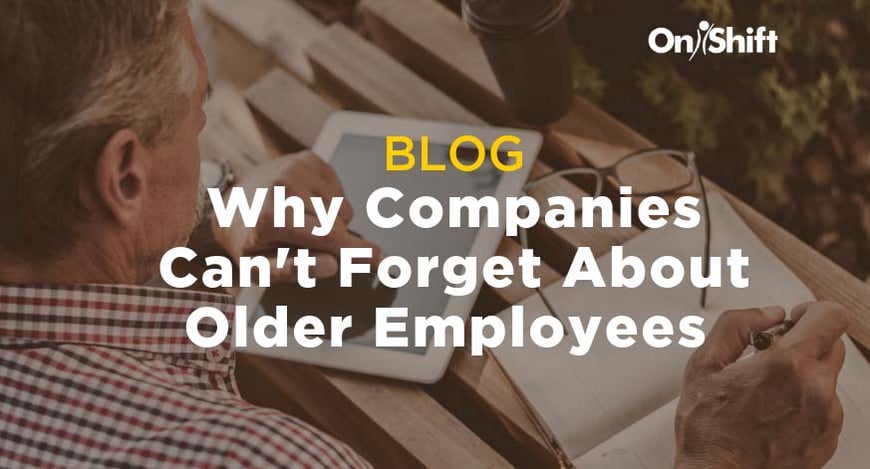September 14, 2018 | Mike Pumphrey
September 14, 2018 | Mike Pumphrey
 We spend a lot of time talking about the impact that millennials have on the economy and job market, and with good reason. As of 2017, according to Pew Research, millennials are the largest generation in the U.S. workforce, with 56 million working, more than either Generation X (53 million) or the baby boomers (41 million).
We spend a lot of time talking about the impact that millennials have on the economy and job market, and with good reason. As of 2017, according to Pew Research, millennials are the largest generation in the U.S. workforce, with 56 million working, more than either Generation X (53 million) or the baby boomers (41 million).
But the baby boomers aren’t simply fading away. As a demographic, they are an imposing force. The U.S. Census Bureau projects that by 2035, people 65 and over are projected to outnumber people under 18 for the first time in history. And these people are working longer than ever before.
While employers look to connect with today’s younger worker, they can’t forget the older employees who also add value and contribute to the success of their organization. Here are three reasons why employers must remember to find, accommodate, retain and sustain these employees.
From a pure numbers standpoint, employers can’t forget about older workers because these workers aren’t forgetting about them. The standard retirement age used to be 55. Yet as of 2014, about 40% of Americans aged 55 or older were working or actively looking for work.
That number is known as the “labor force participation rate,” and it is expected to increase fastest among people aged 65 to 74 and 75 and older. The Bureau of Labor Statistics (BLS) cites three causes of the longer lasting older employer:
Staying in the workforce doesn’t just mean staying at one job. The BLS offers older workers advice on how to change fields later in their careers, while the bureau’s data shows the uptick in part-time work. That is the key element for employers, who can derive benefits from older workers on a limited basis.
The BLS shows that as of 2016, 27% of workers aged 55 and over worked part-time. These employees can bring expertise and experience to companies, so employers must be prepared and able to welcome them into the fold.
It’s cliché to talk about all the ways millennials can help companies, but it also doesn’t tell the full story. In a job market littered with layoffs, older workers offer a range of advantages over millennials, ones that employers would be remiss to disregard.
“You can count on them,” said Blake Nations, CEO of Over50JobBoard.com, in 2015 about older workers. “You can find a maturity in decision-making you don’t find with younger people.”
Maturity and reliability aren’t the only advantages. Older workers are filled with institutional knowledge simply due to their own experiences. They have confidence in their abilities. And they are loyal, a tremendously important trait when we consider that employee turnover can cost as much as $15,000 per employee, as seen in a 2017 study by Employee Benefit News.
Another study from 2013 showed the strength of job satisfaction among older workers. The Associated Press-NORC Center for Public Affairs Research found that 9 out of 10 workers over the age of 50 were somewhat or very satisfied with their jobs. Employers who can find ways to empower and retain older workers will not be disappointed.
Employers who are exclusively focused on engaging, hiring and sustaining younger workers might think that older ones are too different, and that attracting them would require too great a shift in strategy. That could not be further from the truth.
Because while there are differences between different generations of employees, most workers share crucial similarities in what they want out of work regardless of their ages, meaning employers who can work with younger employees can likely work with older ones too. That’s something employers should be aware of, because it might curtail some of the apprehensiveness about what it takes for a company to adapt to older workers.
For instance, millennials, Generation X and boomers all want flexible work schedules. It’s only their reasons that differ.
Those are three different reasons for desired flexibility, yet from an employer’s perspective the difference is negligible: all three groups want flexible schedules and can be approached similarly in that respect.
Another example of similar needs: all age groups want training to improve, refine and augment their skill sets. Older workers might feel as if the world is passing them by, and they want new skills to remain fresh and relevant. As the Deloitte survey shows, younger workers are concerned that the job market — not the world — might pass them by, and that they need to be brought up to speed on skills both technical and personal.
Certainly employers must also explore the ways in which older workers differ from younger ones, but there are also differences within the 55+ demographic itself that employers must consider. Employers who seek to understand those differences will have a leg up on a group of employees that is not just getting older, but getting better.
Subscribe to the OnShift Blog
Recent Posts
Categories
About Mike Pumphrey
Mike Pumphrey is Vice President of Product Marketing at OnShift. His expertise in staffing and labor management strategies in long-term care and senior living is foundational to his role leading OnShift’s Product Marketing team. Mike works hand-in-hand with state and national associations, senior care providers, and with OnShift’s Customer Success and Product teams to create impactful best practices aimed to help solve the daily workforce challenges in senior care. Mike shares insights, research and recommendations to improve clinical, operational, and financial outcomes through regular blog posts and conference speaking engagements.
See for yourself why thousands of providers rely on OnShift’s innovative software for recruitment, hiring, workforce management, pay and engagement. Request your personalized demo today.
